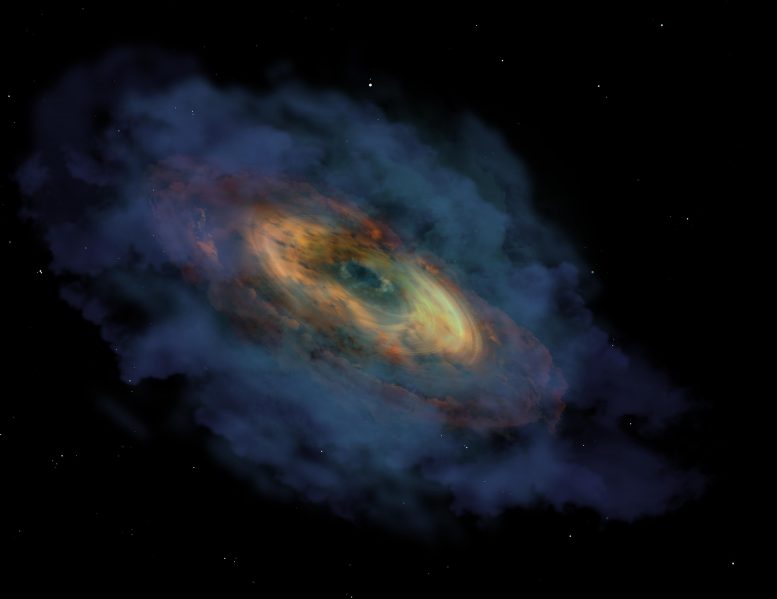
An artist’s impression of the formation of quasar Pōniuā`ena, starting with a seed black hole, 100 million years after the Big Bang. Credit: International Gemini Observatory/NOIRLab/NSF/AURA/P. Marenfeld
Most massive quasar known in early universe discovered on Maunakea.
The second-most distant quasar ever discovered now has a Hawaiian name.
Astronomers have discovered the second-most distant quasar ever found using three Maunakea Observatories in Hawai‘i: W. M. Keck Observatory, the international Gemini Observatory, a Program of NSF’s NOIRLab, and the University of Hawai‘i-owned United Kingdom Infrared Telescope (UKIRT). It is the first quasar to receive an indigenous Hawaiian name, Pōniuāʻena, which means “unseen spinning source of creation, surrounded with brilliance” in the Hawaiian language.
Pōniuāʻena is only the second quasar yet detected at a distance calculated at a cosmological redshift greater than 7.5 and it hosts a black hole twice as large as the other quasar known in the same era. The existence of these massive black holes at such early times challenges current theories of how supermassive black holes formed and grew in the young universe.
The research has been accepted in The Astrophysical Journal Letters.
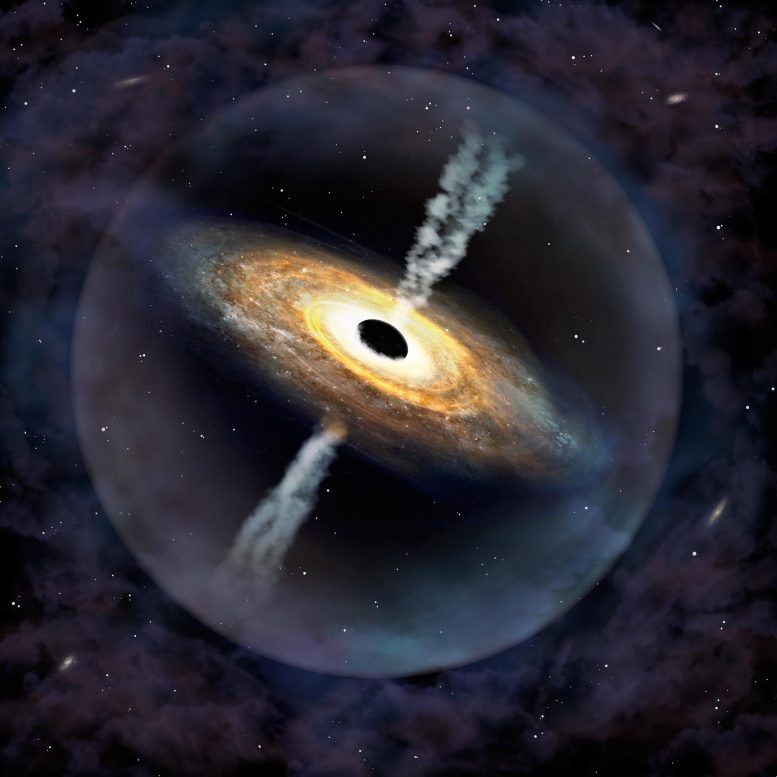
An artist’s impression of the formation of the quasar Pōniuā`ena growing into a billion solar mass black hole 700 million years after the Big Bang. Credit: International Gemini Observatory/NOIRLab/NSF/AURA/P. Marenfeld
Quasars are the most energetic objects in the universe powered by their supermassive black holes and since their discovery, astronomers have been keen to determine when they first appeared in our cosmic history. By systematically searching for these rare objects in wide-area sky surveys, astronomers discovered the most distant quasar (named J1342+0928) in 2018 and now the second-most distant, Pōniuāʻena (or J1007+2115, at redshift 7.515). The light seen from Pōniuāʻena traveled through space for over 13 billion years since leaving the quasar just 700 million years after the Big Bang.
Spectroscopic observations from Keck Observatory and Gemini Observatory show the supermassive black hole powering Pōniuāʻena is 1.5 billion times more massive than our Sun
“Pōniuāʻena is the most distant object known in the universe hosting a black hole exceeding one billion solar masses,” said Jinyi Yang, a postdoctoral research associate at the Steward Observatory of the University of Arizona and lead author of the study.
For a black hole of this size to form this early in the universe, it would need to start as a 10,000 solar mass “seed” black hole about 100 million years after the Big Bang, rather than growing from a much smaller black hole formed by the collapse of a single star.
“How can the universe produce such a massive black hole so early in its history?” said Xiaohui Fan, Regents’ professor and associate department head of the Department of Astronomy at the University of Arizona. “This discovery presents the biggest challenge yet for the theory of black hole formation and growth in the early universe.”
Current theory holds the birth of stars and galaxies as we know them started during the Epoch of Reionization, beginning about 400 million years after the Big Bang. The growth of the first giant black holes is thought to have occurred during that same era in the universe’s history.
The discovery of quasars like Pōniuāʻena, deep into the reionization epoch, is a big step towards understanding this process of reionization and the formation of early supermassive black holes and massive galaxies. Pōniuāʻena has placed new and important constraints on the evolution of the matter between galaxies (intergalactic medium) in the reionization epoch.
“Pōniuāʻena acts like a cosmic lighthouse. As its light travels the long journey towards Earth, its spectrum is altered by diffuse gas in the intergalactic medium which allowed us to pinpoint when the Epoch of Reionization occurred,” said co-author Joseph Hennawi, a professor in the Department of Physics at the University of California, Santa Barbara.
Methodology
Yang’s team first detected Pōniuāʻena as a possible quasar after combing through large area surveys such as the UKIRT Hemisphere Survey and data from the University of Hawai‘i Institute for Astronomy’s Pan-STARRS1 telescope on the Island of Maui.
In 2019, the researchers observed the object using Gemini Observatory’s GNIRS instrument as well as Keck Observatory’s Near Infrared Echellette Spectrograph (NIRES) to confirm the existence of Pōniuāʻena.
“The preliminary data from Gemini suggested this was likely to be an important discovery. Our team had observing time scheduled at Keck just a few weeks later, perfectly timed to observe the new quasar using Keck’s NIRES spectrograph in order to confirm its extremely high redshift and measure the mass of its black hole,” said co-author Aaron Barth, a professor in the Department of Physics and Astronomy at the University of California, Irvine.
In honor of its discovery from atop Maunakea, 30 Hawaiian immersion school teachers named the quasar Pōniuāʻena through the ‘Imiloa Astronomy Center of Hawai‘i’s A Hua He Inoa program led by renowned Hawaiian language expert Dr. Larry Kimura.
“We recognize there are different ways of knowing the universe,” said John O’Meara, chief scientist at Keck Observatory. “Pōniuāʻena is a wonderful example of interconnectedness between science and culture, with shared appreciation for how different knowledge systems enrich each other.”
“I am extremely grateful to be a part of this educational experience – it is a rare learning opportunity,” said Kauʻi Kaina, a high school Hawaiian immersion teacher from Kahuku, Oʻahu who was involved in the naming workshop. “Today it is relevant to apply these cultural values in order to further the well-being of the Hawaiian language beyond ordinary contexts such as in school, but also to ensure the language lives throughout the universe.”
Read Monster Black Hole Found in the Early Universe for more on this research.
Reference
“Pōniuā’ena: A Luminous z=7.5 Quasar Hosting a 1.5 Billion Solar Mass Black Hole” by Jinyi Yang, Feige Wang, Xiaohui Fan, Joseph F. Hennawi, Frederick B. Davies, Minghao Yue, Eduardo Banados, Xue-Bing Wu, Bram Venemans, Aaron J. Barth, Fuyan Bian, Konstantina Boutsia, Roberto Decarli, Emanuele Paolo Farina, Richard Green, Linhua Jiang, Jiang-Tao Li, Chiara Mazzucchelli and Fabian Walter, 1 July 2020, The Astrophysical Journal Letters.
DOI: 10.3847/2041-8213/ab9c26
arXiv: 2006.13452
About NIRES
The Near Infrared Echellette Spectrograph (NIRES) is a prism cross-dispersed near-infrared spectrograph built at the California Institute of Technology by a team led by Chief Instrument Scientist Keith Matthews and Prof. Tom Soifer. Commissioned in 2018, NIRES covers a large wavelength range at moderate spectral resolution for use on the Keck II telescope and observes extremely faint red objects found with the Spitzer and WISE infrared space telescopes, as well as brown dwarfs, high-redshift galaxies, and quasars. Support for this technology was generously provided by the Mt. Cuba Astronomical Foundation.
About W. M. Keck Observatory
The W. M. Keck Observatory telescopes are among the most scientifically productive on Earth. The two 10-meter optical/infrared telescopes on the summit of Maunakea on the Island of Hawai‘i feature a suite of advanced instruments including imagers, multi-object spectrographs, high-resolution spectrographs, integral-field spectrometers, and world-leading laser guide star adaptive optics systems.
Some of the data presented herein were obtained at Keck Observatory, which is a private 501(c) 3 non-profit organization operated as a scientific partnership among the California Institute of Technology, the University of California, and the National Aeronautics and Space Administration. The Observatory was made possible by the generous financial support of the W. M. Keck Foundation.
The authors wish to recognize and acknowledge the very significant cultural role and reverence that the summit of Maunakea has always had within the Native Hawaiian community. We are most fortunate to have the opportunity to conduct observations from this mountain.

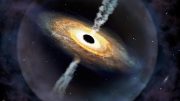
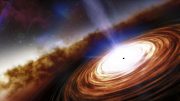
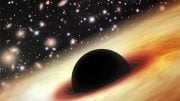
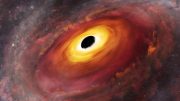
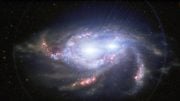
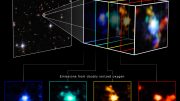

Another nail in the foot of the Big Bang pundits. Such a Black Hole would take the entire age of the universe to reach such a size, so the age of the universe CANNOT be 13.7 Billion years. By plain logic, the universe must be at minimum double that age.
Of course this is another “nail in the foot” of anti-Big bang pundits, since it shows that cosmology has moved on from secured LCDM models to the new science edge: star and galaxy formation [ http://www.sciencemag.org/news/2018/05/galaxy-simulations-are-last-matching-reality-and-producing-surprising-insights-cosmic ].
“Perhaps the simulations’ single biggest lesson so far is not that scientists need to revise their overarching theory of cosmology, but rather that problems lurk in their understanding of astrophysics at smaller scales. In particular, their theory of star formation comes up wanting, …”.
The age of the universe is observed by many independent methods. In fact, it is a major success in cosmology when the self consistent LCDM model was discovered with its 1 % or so precision, since before that the age estimates differed with a factor 2 – some stars were estimated to be older than some estimates of universe age.
That success is almost two decades old by now…
Much older than that even say 4 hundred trillion years old but the matter in said universe much younger. Backholes as we’ve come to call them mite just be giant cookers.I believe atleast one intelligent life form has risen around everyone of the galaxies we see out there and they mite be looking at us right NOW.
It would be appetizing if super massive black holes started out with direct gravitational collapse of gas, similar to how rapid planet formation supports such scenarios.